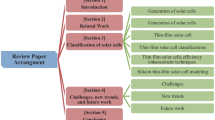Abstract
As a result of comprehensive studies sponsored by NSF and NASA and by the National Academy of Science, it became evident in 1972 that a substantial reduction in production cost to approach 1$/W* and an increase of efficiencies beyond 10% for thin-film and beyond 20% for single crystal solar cells were feasible [1]. With significant government support mainly in the USA, Japan, and Western Europe, rapid progress was made and essentially all technical goals set in 1972 have been achieved and surpassed (thin-film efficiency 12% for CdS/CuInSe2 and 13% for α-Si, single crystal AMl efficiency 23% for Si and 23% for AlGaAs/GaAs; recent Sicells in concentrators have achieved 27% conversion efficiency) [7]. The economic goal (updated for competing with the increased electric energy generation cost and inflationary devaluation of the dollar) seems to be within reach and large quantities of solar panels sell currently for ~5 $/W. The life expectancies of better Si-panels (conservatively estimated) are well in excess of 20 years.
Access this chapter
Tax calculation will be finalised at checkout
Purchases are for personal use only
Preview
Unable to display preview. Download preview PDF.
Similar content being viewed by others
References
Solar Cells, Outlook for Improved Efficiencies, Nat. Acad. Sci., Washington, D.C. (1972).
Proceedings of the 18th IEEE Photovoltaic Spec. Conf. (1985) and of the 7th SERI R & D Review Meeting, May 1986.
M. Wolf., (1971) Energy Conversion, 11, 63.
E. Christensen, (1985),°Flat Plate Solr Array Project’, 10 Years Progress, DOE, JPL, NASA.
W. E. Devaney, R. A. Michelsen and W. S. Chen, (1985), Proc. 18th IEEE Phototvolt. Spec.Conf., 1733.
D. A. Cusano, (1963), Solid State Electr. 6,217.
E. Spenke, (1982), Electronic Semiconductors, McGraw Hill Book Co., New York.
K. W. Boer, (1982), J.Crystal Growth, 59, 111.
S. J. Fonash, (1981),°Solar Cell Device Physics’, Academic Press, New York.
K. W. Boer, (1985), phys. stat. sol. (a), 87, 719.
K. W. Boer, (1981), phys. stat. sol. (a), 66, 11.
K. W. Boer, (1977), phys. stat. sol., 40, 355.
A. Y. Ali, and K. W. Boer, (1985), Proc. 18th IEEE Photovolt. Spec. Conf.
K. W. Boer, (1980), Phys. Stat. Sol. (a), 62, K1.
Author information
Authors and Affiliations
Rights and permissions
Copyright information
© 1987 D. Reidel Publishing Company, Dordrecht, Holland
About this paper
Cite this paper
Boer, K.W. (1987). Solar Cell Theory. In: Physics and Technology of Solar Energy. Springer, Dordrecht. https://doi.org/10.1007/978-94-009-3941-7_2
Download citation
DOI: https://doi.org/10.1007/978-94-009-3941-7_2
Publisher Name: Springer, Dordrecht
Print ISBN: 978-94-010-8248-8
Online ISBN: 978-94-009-3941-7
eBook Packages: Springer Book Archive




